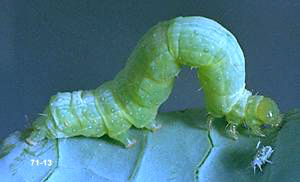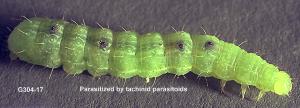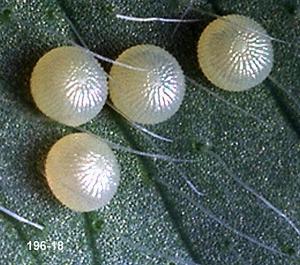|
LOOPER MANAGEMENT |
|||||||||
|
Return to: |
SAMPLING Alfalfa and cabbage looper larvae are usually found in mint
from mid-June to early August. Take 10 straight line sweep net samples in at least five
different sites in fields up to 30 acres. Add an additional sample site for every
additional 10 acres. Count the number of larvae and calculate an average number per sweep
net sample. Field inspections for loopers are usually done at the same time as sampling
for variegated cutworm. Loopers and variegated cutworm will both be found in sweep net
samples and ground search samples. Loopers, unlike the variegated cutworm, can usually be
found on foliage during the day. BIOLOGICAL CONTROL The percentage parasitism or diseased loopers usually exceeds 50 per cent in most fields most seasons and does not cause significant leaf injury. Parasitized loopers can usually be distinguished from nonparasitized loopers by the presence of a black spot on the back of the looper near the back end. Parasitism can be detected by selecting some of the larger loopers from the sweep samples, cutting off the head of each, and pulling each larva apart. A smaller parasite larva will be found inside the looper larva. It is important for growers and consultants to realize that many loopers found in samples are parasitized and will not cause leaf injury. The biological insecticide, Bacillus thuringiensis (Bt) may provide very good control of loopers and small cutworms when applied by ground with a sticking agent and in sufficient water to provide thorough coverage. However, Bt may not control cutworms if they are large and not feeding on the foliage near the top of the plants. If treatment is justified, refer to the registered insecticide section for insecticides and rates for control of loopers. |




